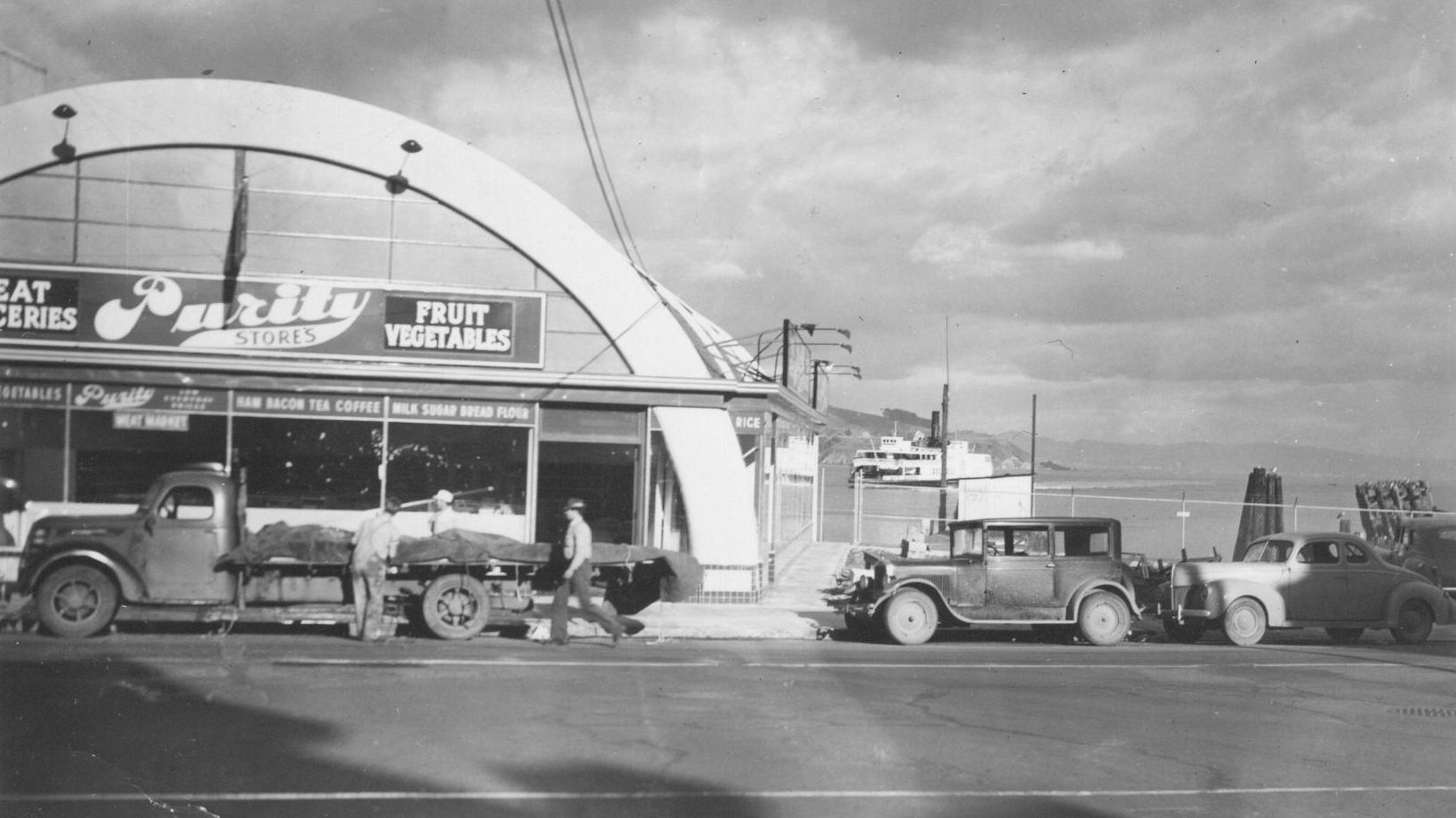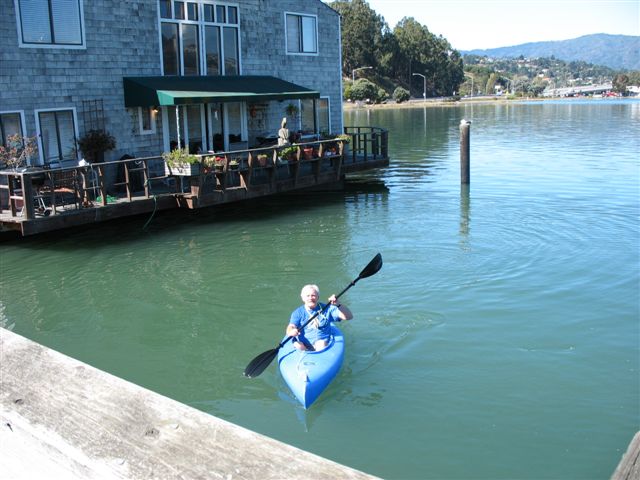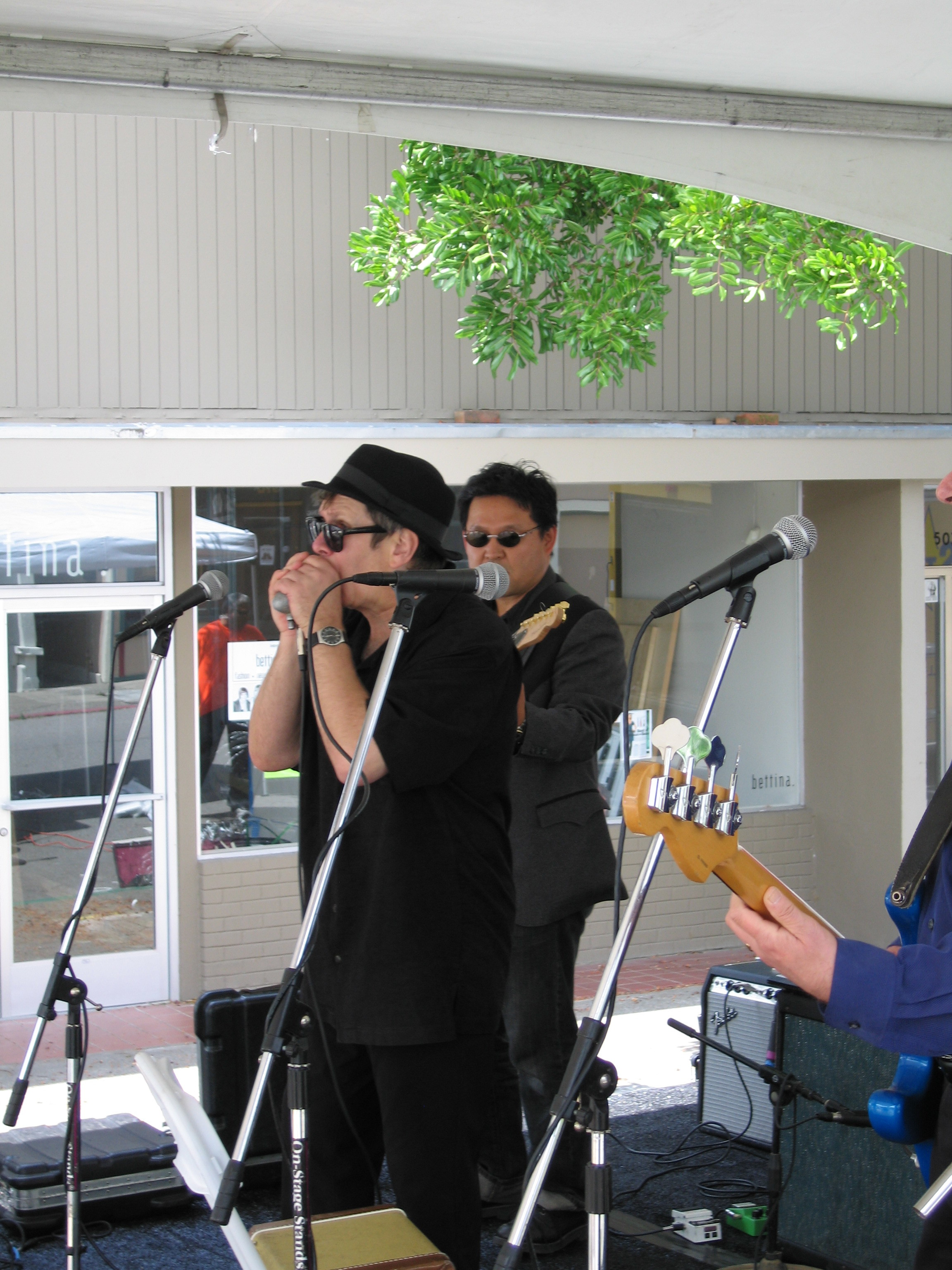Introduction by Larry Clinton, Sausalito Historical Society
Poet and storyteller Keith Emmons lived as an anchor-out for ten years in the 1970s. Here he recounts a legend from that era which he heard from waterfront activist Piro Caro.
By Keith Emmons
Piro told me this story and it’s all about that great big barge-bottom down by the Main Dock in Waldo Point Harbor.
All week long a labor man and that foreman fella Tim Rose and sometimes the new developer, Lew Cook, come by talking. All week long they’re out there hosing off that huge hulk of green and muddy old wood and drift pins sticking up, so they can float that thing out of there and start fixing up the part of the Main Dock they wrecked up a couple of weeks ago. And here’s how that old barge bottom got there.
Donlon Arques on right with TJ Nelsen (author of Drugs Government and the 4th Estate) at left,Chris Hardman (2nd l.) and members of Hardman’s Snake Theatre in the 70s.
© Bruce Forrester
A prosperous woman, a lady of San Francisco, came by one day to Don Arques’ father, years ago. “I’ve seen people here on the waterfront and I’d like to live on a houseboat. I know where I can buy one – may I pull it onto your land?”
Well, of course,” said Don Sr., and told her what she would have to pay for berthage.
Soon enough, in floated a huge hundred-foot barge, loaded with buildings, the wealthy lady, and another, her French maid.
Well, after a year the rich lady disappeared! Nobody knows where she went, and the French maid was left behind. Many months went by and after a while Arques Sr. went out to the barge. “You know,” he said to the maid, “berthage hasn’t been paid on this boat for many months. What are you going to do?”
“O, je ne sais pas!” said the maid.
“You know,” he said, “soon I will confiscate this barge for all its back berthage. What are you going to do?”
O,” repeated the maid, “I don’t know.”
“I have an idea,” said Arques.
“Oui? What is it?”
“Why don’t you marry me?”
Oh, the maid didn’t know, so she told him to come back Tuesday and she’d give him an answer. When he returned she agreed – but with one stipulation: “Seulment deux fois chaque semain!” (Only two times a week.)
As Donlon Arques was seventy at the time, the forty-year old maid was a great temptation. The terms were acceptable, and in a week, if not sooner, the marriage was consummated.
Don Arques Sr. and his new bride began their lives together on the barge by the Main Dock and then one day a huge shark floated in from the ocean, right up off the bow, went belly-up and died. “The old shark dies,” said the people around the Waterfront. A lot of them were Portuguese then and they called the old man “the Shark.” Sure enough, just two weeks later Don Arques Sr. died. And just a little while after that, probably from a broken heart and a lack of exercise, the French maid died too.
Well, this was a problem, because when Arques Sr. died the whole Waterfront from Gate 3 to Gate 6 became the property of his new wife! And when she died it looked like our whole shore-side would go into the hands of her grown-up children and nobody even knew who they were.
And Donlon Arques Jr. was going to lose everything! And to strangers!
But he had a plan.
Don Arques Jr. had a note from his Dad, an IOU for $40,000 which was a great deal of money at that time. So, in order to collect on his Dad’s debt, Don Jr. forced a public auction of his Dad’s Sausalito shoreline to raise the money. But Don Jr., was fond of this Richardson Bayside, and way too shrewd to lose it at a public auction. He had a plan.
Francine and Wally Mays, of the Bayhaven ferryboat harbor, were living around here then and they decided that, just for fun, they’d go to the auction on the steps of City Hall and bid up the price. They arrived at the steps at twelve noon, auction time.
obody there.
They waited till 12:15. Then 12:30. Then they went in to inquire.
“Oh,” said the Clerk, “that’s already been handled. Mr. Arques bid on that yesterday for $15,000. It’s his now.”
Don Jr. had fixed it all up behind closed doors and had already bought the place.
“And so, I just wonder about our situation today,” said Piro several years later, “‘cause it looks like Donlon Arques Jr. just now sold to developers a bunch of shoreline he bought at an illegal non-existent public auction twenty-five years ago. I guess maybe nobody’s owned it since then – just like we always thought. Or maybe it belongs to the widow’s long-lost kids. Too bad they’ve never been down here. We’ve been living and taking care of this shoreline all these years: it must be ours by now.”
Don Jr. left what had been the Arques Shipyard and Marina to a charitable educational trust and a maritime preservation foundation, but his heirs sold the property to developers Joe Lemon and his son, Joe Jr., in 2007.
Keith’s collection of poems about the 70s waterfront, “Moondrifter Reverie,”
is available at the Library, from the publisher (Red Mountain Press) and at Book Passage.





















